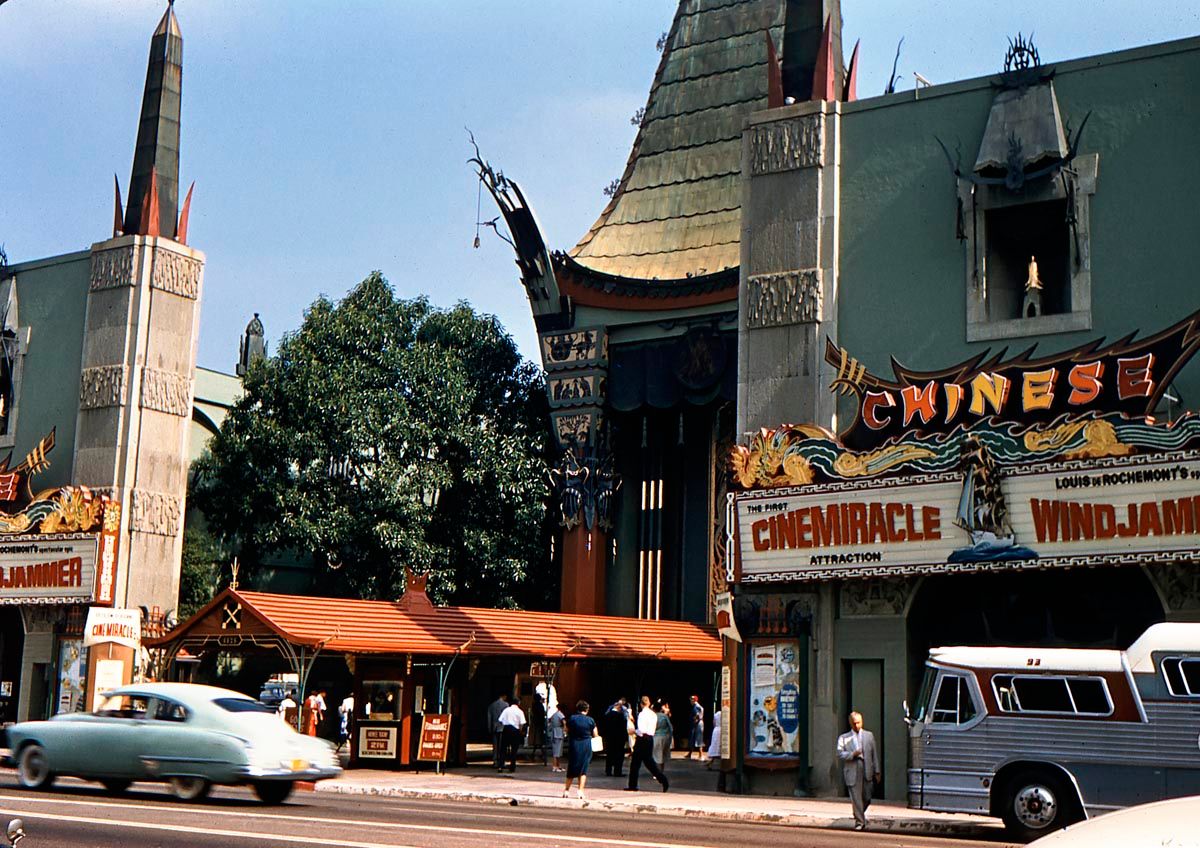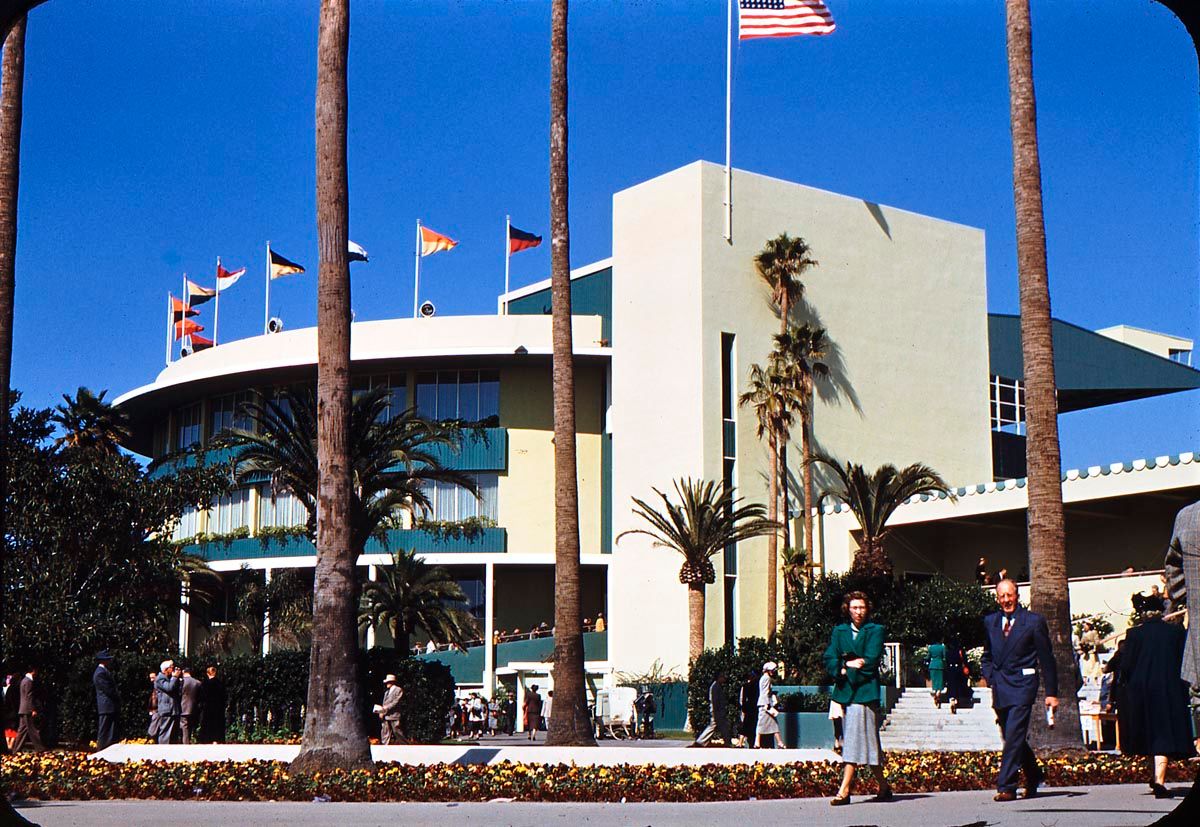"Anything Goes" Saturday - Around California
Today we're going to visit a few Southern California landmarks - in the 1950's! I love SoCal's history, which seems so colorful and glamorous when looking back through rose-colored lenses. My grandmother moved to Los Angeles in 1921, and I used to listen to her stories of all the places she and my grandpa liked to go for fun.
Here's a photo of the world-famous Grauman's Chinese Theater, on Hollywood Boulevard. It opened in 1927, and became the site of many film premiers. The footprints and handprints in the forecourt still draw thousands of tourists a year. One interesting thing about this photograph is that the film being shown, "Windjammer" (a documentary that followed the voyage of a 17,500 nautical-mile sailing trip by the Norwegian vessel Christian Radich), is the only film to be produced in "Cinemiracle". Cinemiracle was a wide-screen (2.59:1) format that used three cameras and two mirrors which (according to Wikipedia) "... gave the left and right cameras the same optical center as the middle camera; this made the joins between the projected images much less obvious than with Cinerama". The patents for Cinemiracle were eventually bought by Cinerama, and that was the end of that.
This is a picture taken out in front of the Hollywood Park racetrack, from around 1950. Look at how nice everybody dressed to bet on the ponies! The track opened in 1938, and had many its board of directors was a Hollywood "who's who"; Jack Warner, Raoul Walsh, Mervyn LeRoy, Al Jolson, Wallace Beery, Bing Crosby, Joan Blondell, Sam Goldwyn, and some guy named Walt Disney.

9 comments:
Major, I love seeing vintage shots like these. I hope you have more! :-)
Eeeew, one of the security words below is "purulent".....look it up!
I do miss the class of it all...
That was cool!!
It's nice to see Grauman's, in its short-lived "Cinemiracle days" in a shot other than that of the post card views from the time.
And as far as Cinemiracle's so-called superiority over Cinerama - that remained to be seen (no puns, here). The use of mirrors on the 'A' & 'C' projectors was merely a way around the Cinerama patents. They both suffer (in addition to visible join lines) the side-effect of a disjointed horizon when the cameras shoot either above or below the horizontal axis. Neither were a perfect system, but the visual effect created from their all-encompassing images are still breathtaking when viewed in the proper setting. And quite frankly give some pause to another resurrected filming "gimmick" from the same era: 3D
My Uncle Mack Lunt worked on Windjammer as a projectionist working on perfecting the process. When Cinerama bought out Cinemiracle, they bought the staff also, and Uncle Mack went to work for Cinerama, where he worked on How The West Was Won and It's a Mad, Mad, Mad, Mad World. Mack was one of the men who developed the process (publicized as "one-camera Cinerama") in which IAMMMMW was shot. Then he left Cinerama to go shoot a Circle-Vision film for the New York World's Fair (The NY Port Aurthority Pavillion showed Uncle Mack's Circle-Vision movie), and where he was the chief of projection systems for the entire Fair. This was how I got to go to the Fair. We went and stayed in Uncle Mack's home, and got in free to everything.
Major -- great pics -- I was just to Wal-Mart so these pics of appropriately dressed, normal looking people is refreshing!
TM!, I have more!
Katella, I agree.
Connie, thanks!
Nanook, I wish I could see an original Cinerama (or Cinemiracle!) movie projected the way it was intended. I've seen "How the West Was Won" on TV, and those areas where the images join are always distracting as hell.
Doug, wow, very cool. I would imagine that your uncle had a million amazing stories from his career.
Gojira, that's what you get for going to Wal-Mart!
Major-
You may want to take a pass on Windjammer, for as the description says: 50 Norwegian young boys set sail on the training ship, 'Christian Radich' to learn the art of sailing and seamanship. They learn to know, depend upon and trust each other during their various ports-of-call.
Yes, I suppose some of the scenes in the "various ports 'o call" hold nostalgia interest, but the sad fact is only How the West Was Won really holds up as the only Cinerama experience where you won't walk out of the theatre feeling as if you've just "...lost two hours of your life you'll never get back again". I know - just my opinion, but worth considering. Especialy when HTWWW does play occasionally at the Cinerama Dome.
Excuse me, Nanook, but George Pal's The Wonderful World of the Brothers Grimm is a delightful movie, vastly superior to the episodic and jingoistic How the West Was Won, entertaining as HTWWW is. (And given my Uncle worked on HTWWW - and got me in to see it in its original release for free - but not on WWOTBG, I ought to be prejudiced the other direction.)
The great film critic Pauline Kael said of How the West Was Won: "How the West was Lost would be a more-appropriate title for this dud epic, since, as conceived by the writer, James R. Webb, the pioneers seem to be dimwitted bunglers who can't do anything right. The film is in three chunks."
I'm not as hard on it as that: it has magnificent photography, some great action sequences, some excellent actors giving fine performances (Debbie Reynolds, Robert Preston, Thelma Ritter, oddly enough George Peppard who is usually not very good, and Carrol Baker, who was never much of an actress, but who is very good in this movie), but also a lot of terrible performances from badly miscast actors, some usually good actors with badly written roles, like Fonda, Karl Malden, Agnes Morehead (Kael calls her performance "Shameful"), and Jimmy Stewart, and some always-terrible actors miscast, like John Wayne), and a terrific musical score. Really, the music is the best thing about it.
Further, many of the non-fiction Cinerama travelogues are very entertaining and especially beautiful to behold in the full process. About 6 years ago I got to see This is Cinerama in the original process, and a NEW print, at the Cinreama Dome, and while it's hit or miss throughout, the hits hit it out of the park.
Major, Yes, my Uncle had many great stories. Sadly, he passed away almost 20 years ago. It was through his help and conections that my brother became a sound mixer at MGM for a few years. (He mixed the soundtrack for the early seasons of Dallas, which used to shoot on the old MGM lot. He knew who shot JR, since he mixed the sound for the "reveal" episode, and for the false versions they did to throw people off.)
In the recent DVD re-release of How the West was Won, they used a new computer process to "join" the three images, and it works almost perfectly. The joins are not nearly so distracting, and moments where the color values of one image vary wildly from the other two are much rarer. Of course, having one image with three focal points is still highly disorienting, as it's just wrong to the eye.
Anyway, it looks a lot better on the newer DVD, which also includes a fascinating documentary on Cinerama, which includes clips from all the 3-camera Cinerama films but re-transferred in this new image-joining process.
(On the 2-disc DVD set of the original King Kong there is a documentary on Merian C. Cooper which includes the climactic cross-country airplane view of America from This is Cinerama entire, in the new, improved image-joining process.)
In directing Cinerama films, directors needed to teach actors to look to the side of the person they were supposed to look in the eye, because it looked right on the screen in that format. Actors found it highly irritating and difficult to work that way.
Russ Tamblyn holds the record: he is the only actor to appear in both of the fiction movies made in the three-camera Cinerama process.
Post a Comment